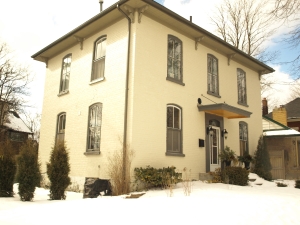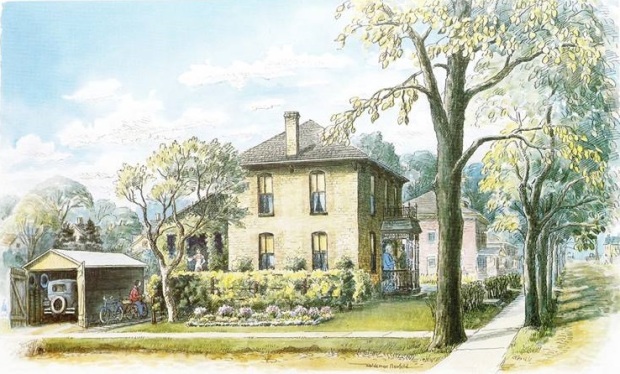Stories from the MacGregor/Albert Heritage Conservation District: 35 Central St and Woldemar Neufeld

The house at 35 Central (formerly Church) Street is one of our older houses in the MacGregor/Albert neighbourhood and in the City, believed to have been built about 1871. It was built in the Italianate style with large decorative brackets below the eaves. Having not found the early residents of the house as yet, we do know that by 1911, Adolph Egener’s family lived here and between 1921 and 1935, the Janzen/ Neufeld family lived here. I asked Paul Tiessen, co-author with his wife Hildi of a number of publications on the works of Woldemar Neufeld, to write a piece on Woldemar and 35 Central (Church) Street.

A painting of the Janzen/Neufeld residence, by Woldemar Neufeld. The home features a stone foundation, double brick walls and deep eaves with decorative brackets. (Copied with consent of the Woldemar Neufeld Estate. The painting is part of the Conrad Grebel Collection.
The Janzen/Neufeld family fled the USSR in the fall of 1924, the father, Jacob H. Janzen – a Mennonite poet, playwright, and preacher – having been warned that he was under surveillance. Only the year before he had married Eliese (Reimer) Neufeld. Both had been recently widowed in the tumult following the Revolution. With their combined family of ten children they – along with many other Mennonites – arrived in Waterloo between Christmas and New Year, 1924. They were parceled out to various Mennonite farms north and west of Waterloo. The fifteen-year-old Woldemar, already determined to become an artist, went to live on the Eldon Hunsberger farm west of St. Agatha.
In August 1925, Woldemar’s parents managed to purchase the house at 35 Church (Central) Street, and called their scattered children home. Woldemar (along with step-siblings Hardy and Martha) went to school across the street at Central (now MacGregor) school, where he finished grades 7 and 8, and where his teacher, a Miss Watson, encouraged his artistic efforts.
Jacob Janzen – when he was not travelling in Canada or the United States on behalf of the Mennonite church – would join his family in walks to Sunday concerts in Waterloo park. Friends and neighbours came to realize that it was a matter of some priority for the Janzens to get a piano in their home, while extra money for furnishings came only after a great deal of hard labour in Waterloo and area households and factories, and on farms. Three of the Janzen/ Neufeld girls worked for weeks before they could announce one Friday to others at the Forsyth Shirt Factory in Waterloo that now they had saved enough to buy some curtains for their house. But the following Monday they admitted that they had spent their money on a concert in Toronto that weekend!
At home, Janzen insisted on a quiet “Abendstunde” (eveninghour) when Helga, Woldemar’s step-sister, would provide a piano recital. A half century later, in 1982, when Neufeld was honoured at a major retrospective of his work at an exhibition in Waterloo, the special events included a recital by Helga.
In 1927, perhaps to keep the handsome Woldemar away from the “Canadian girls” at Kitchener-Waterloo Collegiate, and certainly to get for him the kind of serious training in religion and German he would have received at a Mennonite school in Russia, Woldemar, along with Hardy, was sent a few blocks away to Waterloo College school for boys, where he was taught mainly by Lutheran Seminarians enrolled at Waterloo College (now Wilfrid Laurier University). He was overjoyed at the seriousness accorded to art training, complete with full-fledged exams. He managed to finish four grades in three years.
Meanwhile, his parents frequently entertained guests at their Church Street home, often Mennonite leaders from various locations across North America. On the Fountain Street side of the property, Woldemar helped to erect a one-car garage, and he built a grape arbour that ran along the side of the house. In 1933 he met Peggy Conrad, who lived at 34 Young Street, one of those “Canadian girls” who had attended the Kitchener-Waterloo Collegiate. They were married in Waterloo College chapel in 1939. In 1934 and 1935 Woldemar had one-man exhibitions of his art, and in 1935 moved to Cleveland to study at the Cleveland School of Art. He visited and painted Waterloo often for the rest of his life, while living in Cleveland, New York City, and, finally, Connecticut, where he died in 2002. His father, who had become a Mennonite bishop, and his mother both died in Waterloo in 1950.
by Sue Enns and Paul Tiessen



